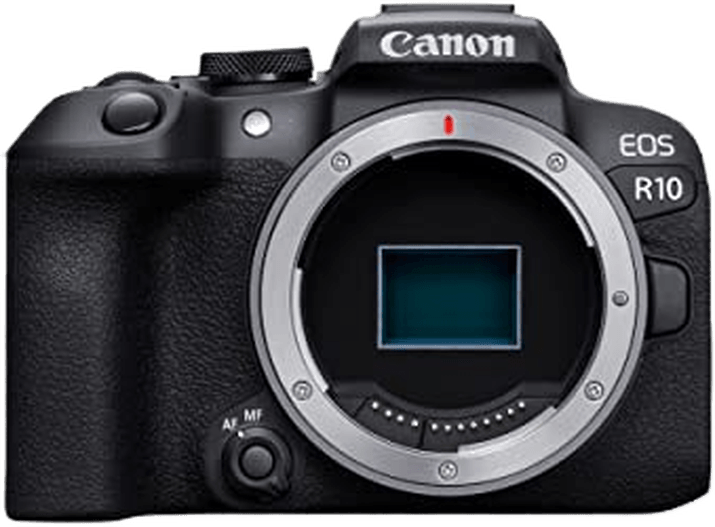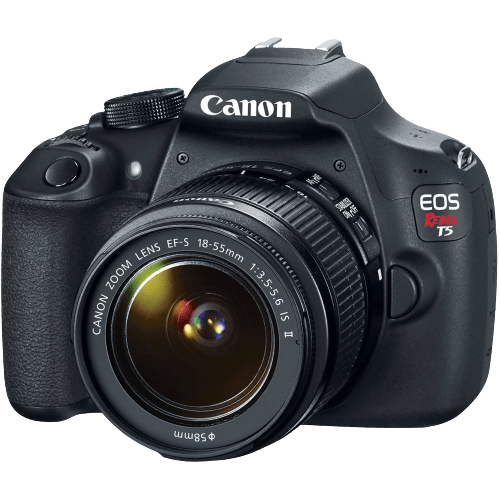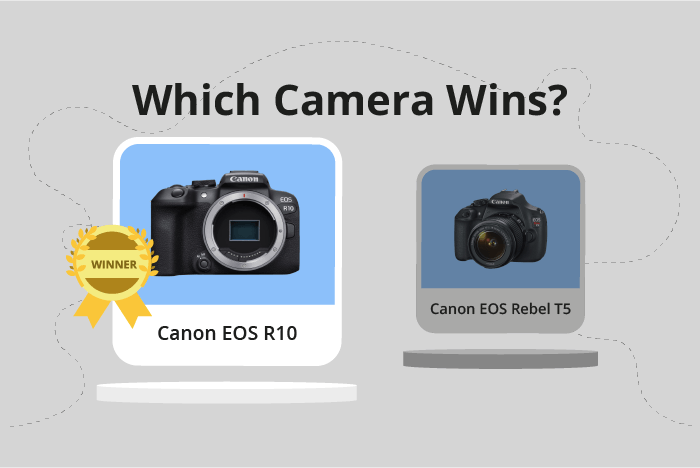Canon EOS R10 vs EOS Rebel T5 / 1200D Comparison
Canon EOS R10

Canon EOS Rebel T5 / 1200D

The Canon EOS R10 outperforms the Canon EOS Rebel T5 / 1200D with a significant difference of 31 points in our scores, achieving 69/100 compared to the Rebel T5’s 38/100. Both cameras share some common specifications, such as being part of the Canon EOS family and having similar size dimensions. However, the R10 is a mirrorless camera released in 2022, while the Rebel T5 is a DSLR from 2014.
The EOS R10’s higher score reflects its better performance and features, such as being lighter (426g vs. 480g) and having a more recent release date, which usually means improved technology. On the other hand, the Rebel T5 has a lower launch price of $500, making it a more budget-friendly option.
Taking all factors into account, the Canon EOS R10 is the superior camera due to its better performance, lighter weight, and more modern technology. However, for those on a tight budget, the Canon EOS Rebel T5 / 1200D might be a more suitable choice.
Canon EOS R10 vs EOS Rebel T5 / 1200D Overview and Optics
The Canon EOS R10 emerges as the clear winner in the optics comparison with a score of 71/100, significantly outperforming the Canon EOS Rebel T5 / 1200D, which scores only 39/100. Both cameras share some common specifications, such as the CMOS sensor type, APS-C sensor size, and the absence of image stabilization.
The EOS R10 surpasses the Rebel T5 / 1200D in several aspects. With 24 megapixels, it offers a higher resolution than the 18 megapixels of the Rebel T5 / 1200D. This allows for more detailed and sharper images. The R10 also boasts a superior shooting speed of 15 frames per second, compared to the mere 3 frames per second of the Rebel T5 / 1200D, enabling better capture of fast-moving subjects. Furthermore, the R10 is equipped with a more advanced Digic X processor, providing faster performance and improved image quality. Lastly, the R10 has a higher DXOMARK sensor score of 97, compared to the 63 of the Rebel T5 / 1200D, reflecting its overall better image quality.
The Rebel T5 / 1200D, however, has a minor advantage in its lens mount compatibility. It uses the Canon EF-S lens mount, which is compatible with a wider range of affordable Canon lenses. The R10, on the other hand, utilizes the newer Canon RF lens mount, which may have fewer budget-friendly lens options available.
Taking all these factors into account, the Canon EOS R10 proves to be a superior camera in terms of optics, offering higher resolution, faster shooting speed, and better image quality. The Rebel T5 / 1200D’s main advantage lies in its lens compatibility, which may be beneficial for those on a tighter budget. Nonetheless, for those seeking the best optical performance, the R10 is the clear choice.
Canon EOS R10 vs EOS Rebel T5 / 1200D Video Performance
The Canon EOS R10 outperforms the Canon EOS Rebel T5 / 1200D in video capabilities, boasting a video score of 91/100 compared to the Rebel T5’s 43/100. Both cameras offer some common specifications, such as the ability to shoot video in varying resolutions and frame rates. However, the EOS R10 surpasses the Rebel T5 in several aspects, making it the superior choice for videographers.
The EOS R10’s video resolution reaches up to 4K with maximum dimensions of 3840 x 2160, while the Rebel T5 only offers Full HD with dimensions of 1920 x 1080. This difference allows the EOS R10 to capture more detailed and higher quality videos. Additionally, the EOS R10 supports a maximum video frame rate of 120fps, enabling smoother slow-motion footage compared to the Rebel T5’s 30fps limit. The R10 also features built-in time-lapse functionality, which the Rebel T5 lacks, providing an extra creative option for users.
Despite its lower video score, the Rebel T5 still serves as a decent entry-level camera for those looking to explore video recording without investing in a higher-priced model. Its Full HD resolution and 30fps frame rate are sufficient for casual videographers and beginners, but may not satisfy more advanced users.
Given the significant differences in video capabilities, the Canon EOS R10 emerges as the clear winner for those prioritizing video performance. With its 4K resolution, higher frame rate, and time-lapse feature, it caters to a variety of creative needs and produces superior quality footage. The Rebel T5, while adequate for beginners, falls short in comparison and may not meet the demands of experienced videographers.
Canon EOS R10 vs EOS Rebel T5 / 1200D Features and Benefits
The Canon EOS R10 emerges as the winner in this comparison, scoring 70/100 in features, while the Canon EOS Rebel T5 / 1200D scores 36/100. Both cameras share some common specifications, such as a 3-inch screen size and the absence of GPS. However, the EOS R10 outperforms the Rebel T5 / 1200D in several aspects, making it a better choice for photographers.
The EOS R10 boasts a higher screen resolution of 1,040,000 dots compared to the Rebel T5 / 1200D’s 460,000 dots, providing clearer and more detailed image previews. Additionally, the EOS R10 features a touchscreen, which simplifies menu navigation and settings adjustments, while the Rebel T5 / 1200D lacks this functionality. The EOS R10 also has a flip screen, allowing for more versatile shooting angles and easier self-portraits.
In terms of connectivity, the EOS R10 outshines the Rebel T5 / 1200D with built-in Wi-Fi and Bluetooth capabilities, facilitating seamless image transfer to compatible devices and remote camera control. The Rebel T5 / 1200D, on the other hand, does not offer these features.
Despite its lower score, the Rebel T5 / 1200D still has some advantages, such as a flip screen, making it suitable for those who prioritize this feature. However, it falls short in other areas compared to the EOS R10.
Given the significant differences in feature scores and the numerous advantages of the EOS R10, it is evident that the Canon EOS R10 is a superior camera compared to the Canon EOS Rebel T5 / 1200D. The EOS R10’s enhanced screen resolution, touchscreen, and connectivity options make it a more versatile and user-friendly option for photographers of all levels.
Canon EOS R10 vs EOS Rebel T5 / 1200D Storage and Battery
The Canon EOS R10 outperforms the Canon EOS Rebel T5 / 1200D in storage and battery with a score of 40/100, while the Rebel T5 scores 27/100. Both cameras have one memory card slot and accept SD, SDHC, and SDXC cards. However, the R10 is compatible with UHS-I cards, providing faster read and write speeds.
The R10’s battery life is slightly lower at 450 shots compared to the Rebel T5’s 500 shots, but its LP-E17 battery type compensates with USB charging capabilities. The Rebel T5 uses an LP-E10 battery, which lacks USB charging. The R10’s USB charging feature makes it more convenient for on-the-go photographers, as they can recharge their camera without needing a separate charger.
Despite having a lower storage and battery score, the Rebel T5 offers marginally better battery life. However, the R10’s compatibility with faster memory cards and USB charging capabilities make it a superior choice in terms of storage and battery performance.
Canon EOS R10 vs EOS Rebel T5 / 1200D – Our Verdict
Are you still undecided about which camera is right for you? Have a look at these popular comparisons that feature the Canon EOS R10 or the Canon EOS Rebel T5 / 1200D:

